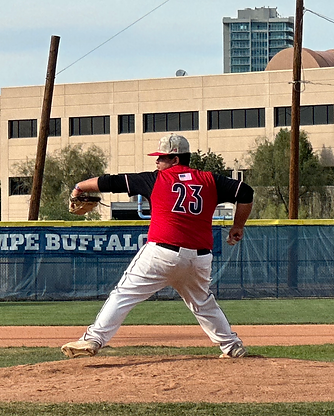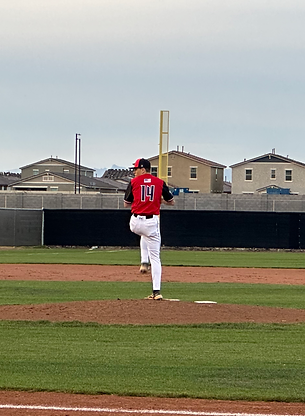
Juan Anaya pitching against Tempe on March 27. He had six strikeouts. (Photo by Lexus Matos)

Easton Carleton pitching against Tempe on March 24. He had nine strikeouts. (Photo by Lexus Matos)

Ian Anderson pitching against Paradise Honors on March 6. (Photo by Lexus Matos)
While the Dysart Baseball program takes its journey through their new region, they also have to adjust to the new pitch clock rule in Arizona high school baseball. The first time I was introduced to the new rule was back in February when I walked onto the field for Dysart’s scrimmage against Glendale. I immediately noticed the unusual number of umpires that were at the game. This prompted many questions in my head since it is timely that Major League Baseball (MLB) has also implemented the pitch clock this season.
One of the umpires at the scrimmage, Larry Myers, explained that teams have 90 seconds to warm up and pitchers have 20 seconds to pitch. He also explained that both pitchers and batters can get violations. Batters will receive a strike and pitchers will receive a ball in their counts. Myers said, “If he steps off and does a legal fake to a base, then it resets the clock, but stepping off does not reset the clock.” Other situations that Myers listed that can reset the clock are foul balls, calling timeouts, or any dead ball situation.
The purpose of the new pitch clock is to speed the game up. Myers said that there were many games that lasted two to three hours. Myers mentioned that the NCAA and MLB has also implemented the pitch clock. “It was partially influenced by what was seen in the past and it was working there so it’s filtered down to the high school level,” said Myers. The goal of the pitch clock is to get the games to last less than two hours according to Myers. Last year, Myers had games that lasted almost three hours when he umpired.
This will be a learning curve for all teams and even the umpires as they navigate the new rule and how to properly enforce it. Myers said that it might take four or five games for umpires to enforce the clock “consistently and habitually.” Myers said, “in my experience, games are always better when the pace of the game is faster.”
During the scrimmage against Glendale, it appeared that neither team was affected by the pitch clock. One of Dysart’s pitchers, Jacob Moreno, said that the pitch clock was weird at first, but the team will eventually adapt to it. Head Coach Kevin Carleton said, “I understand the rule, but I don’t like it. It’ll take a while to get used to it.” Carleton mentioned that one of his pitchers had difficulty with adapting to the new rule. However, his pitcher was able to understand the rule once they had explained it.
Other rules that Myers mentioned that are new to the high school level are coaches are required to wear helmets on the field and pitchers cannot have a hybrid pitching position. Umpires had confusion on pitchers using the hybrid position and whether it was fair or considered a balk. Myers explained that pitchers must have a clear and defined windup and set position. With these new rules in place, we will see how the game of baseball will evolve and adapt.
Written by Lexus Matos